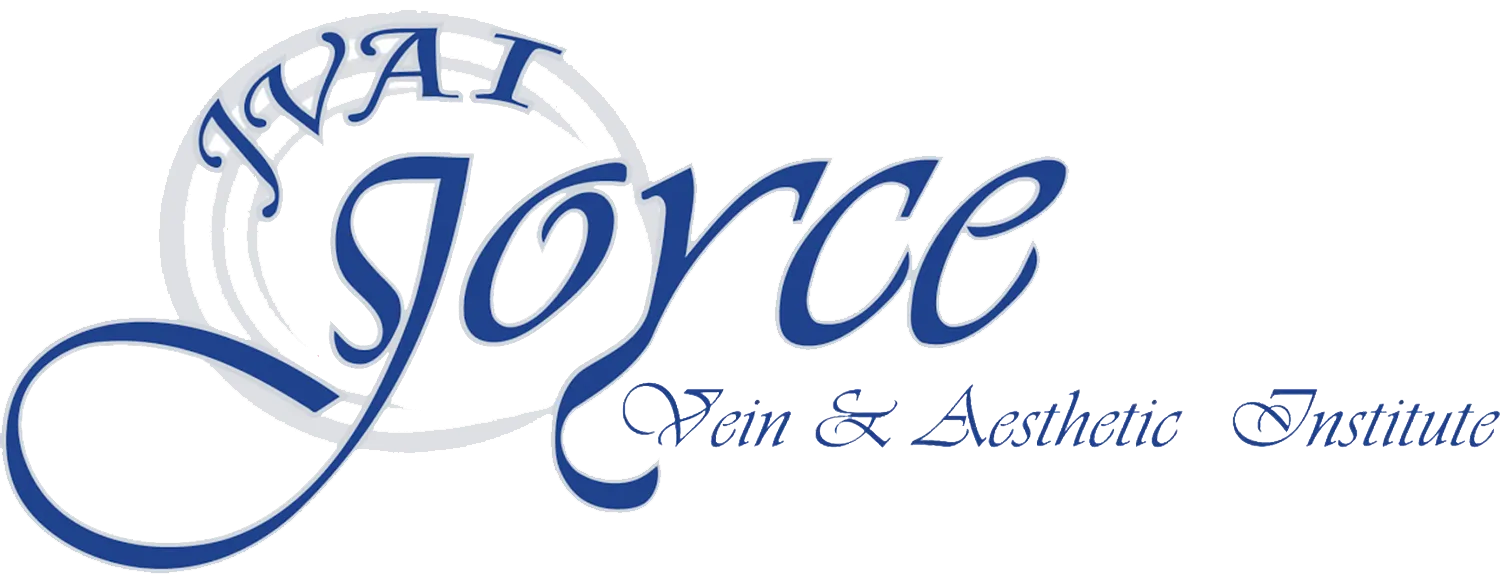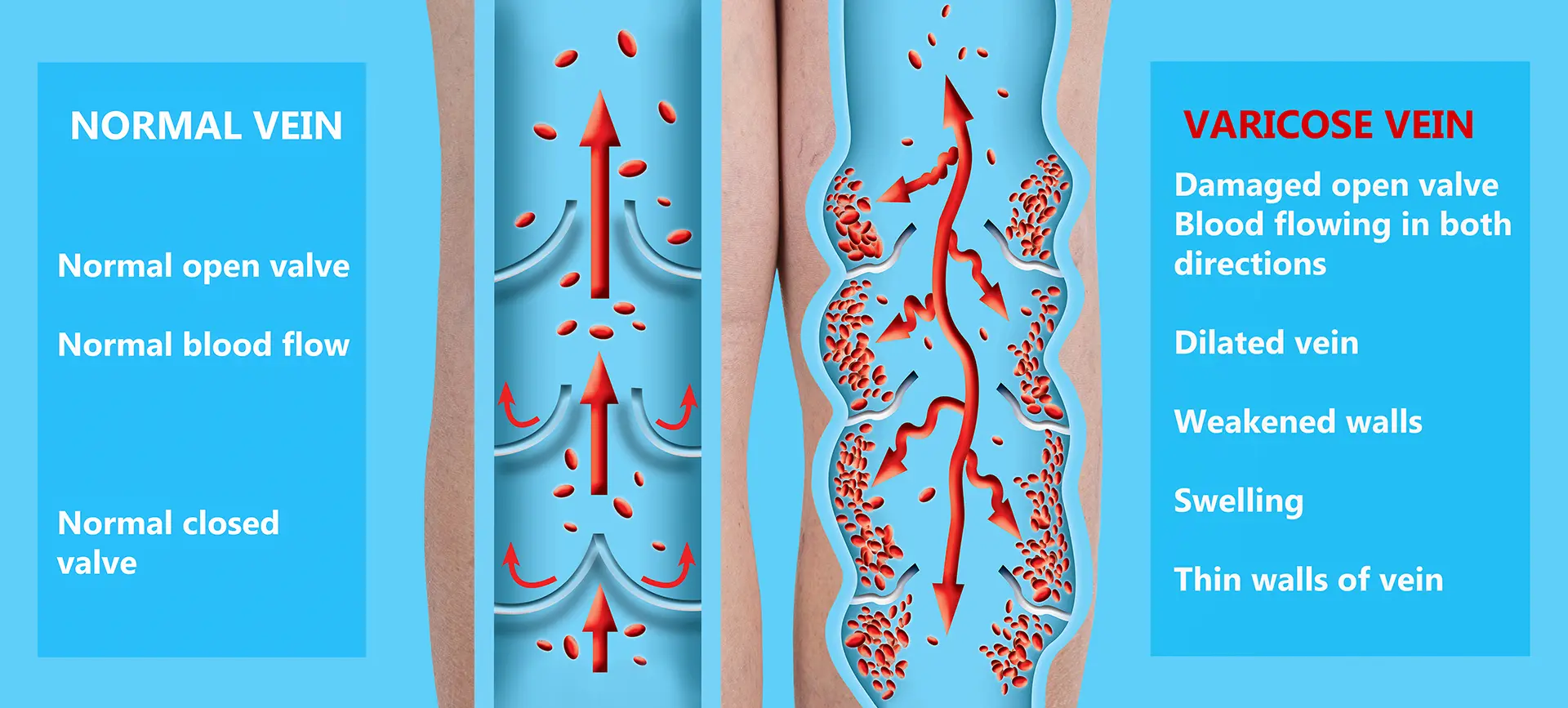Vein Treatments
Varicose Veins
Varicose veins and spider veins are often the first sign of serious underlying venous disease. Left untreated, venous disease can result in swelling or edema, prominent varicose veins, skin discoloration, skin thickening and even painful, debilitating venous leg ulcers. The information below will help you understand how the venous system works and determine if you need treatment at a vein center.
Symptoms
- Visible swollen veins: Twisted, enlarged veins that are dark purple or blue in color, often appearing on the legs or feet.
- Pain or heaviness: A feeling of heaviness or discomfort in the legs, especially after standing or sitting for long periods.
- Swelling: The legs or ankles may swell, particularly at the end of the day.
- Aching or cramping: Some people experience aching, throbbing, or cramping in the affected area.
- Itching or burning: The skin around varicose veins can feel itchy or irritated.
- Skin discoloration: Over time, varicose veins can lead to skin changes, such as brown or reddish discoloration, particularly near the veins.
- Tired or restless legs: You might feel a constant need to move your legs to relieve discomfort.
- Ulcers or open sores: In severe cases, varicose veins can cause skin ulcers near the affected veins.
Chronic Venous Insufficiency
Chronic Venous Insufficiency (CVI) is a condition where the veins in the legs are unable to efficiently return blood to the heart. This occurs when the valves in the veins, which help blood flow upward against gravity, become damaged or weakened. As a result, blood starts to pool in the lower legs, leading to symptoms like swelling, pain, heaviness, and varicose veins.
CVI can develop over time due to factors such as:
- Weak vein walls or valves – These help keep blood flowing in the correct direction. If they’re damaged, blood can flow backward, leading to venous stasis.
- Increased pressure in the veins – This could be due to pregnancy, obesity, prolonged standing, or a sedentary lifestyle.
- Age – The risk increases as you get older, as veins naturally weaken over time.
Common symptoms of CVI include:
- Swelling in the legs or ankles
- Aching, heaviness, or pain in the legs
- Visible varicose veins
- Skin changes (e.g., darkening of the skin, ulcers)
In severe cases, CVI can lead to ulcers or open sores on the legs.
Venous Leg Ulcers
Skin discoloration, thickening and ulcers of the lower legs are often caused by incompetent perforator veins in the calf. Perforator veins connect the high pressure deep veins of the leg with the veins just under the skin. Dr. Joyce, one of the world’s most experienced perforator vein surgeons, was one of the first surgeons in the world to realize the link between perforator dysfunction and venous leg ulcers. Under his care, hundreds of formerly untreatable, long-term leg ulcers have been healed.

Spider Veins
Spider veins are small, dilated blood vessels near the surface of the skin, these veins look like tiny, web-like clusters, typically in shades of red, blue, or purple. They are a type of varicose vein but are smaller and less raised.
Causes
They can be caused by factors such as genetics, aging, hormonal changes (pregnancy, menopause, birth control), prolonged standing or sitting, obesity, and sun exposure.
Symptoms
While spider veins are often asymptomatic, some people may experience discomfort, a feeling of heaviness, or mild aching in the affected area.
Common Areas
They are most commonly found on the legs and face, especially around the thighs, calves, and ankles.
Treatment Options
Treatments can include sclerotherapy (injecting a solution into the vein) or laser therapy.
Outlook
While spider veins are generally harmless and may not cause symptoms, they can occasionally be associated with underlying vascular issues like venous reflux disease or varicose veins.
Endovenous Laser Ablation
Endovenous Laser Ablation (EVLA) is a minimally invasive procedure used to treat varicose veins by using laser energy to close and seal off the affected veins.
How it works?
A laser fiber is inserted into the vein through a tiny incision. The laser emits heat that causes the vein to collapse and seal shut. Blood is then rerouted to healthier veins.
Procedure
The procedure is performed using local anesthesia. A fiber optic laser catheter is inserted into the vein. Laser energy is introduced trough the catheter to close the vein. IT usually takes 10-15 to complete.
Benefits
- Minimally invasive Incisions less than 3 mm.
- Fast recovery time, most patients can return to normal activities within 24-48 hours.
- Effective for treating large varicose veins and venous ulcers.
- Patients experience minimal discomfort compared to traditional vein stripping surgery.
- Done in the office setting.
Recovery
Most people can resume regular activities shortly after the procedure, though some may experience mild bruising, swelling, or soreness in the treated area.
Effectiveness
EVLA has a high success rate, most patients experiencing significant improvement or complete resolution of symptoms. The results are long-lasting.
Outlook
Endovenous laser ablation offers a quick, safe and effective solution for varicose veins, with most patients reporting a significant improvement in the appearance of their legs and quality of life.

Microphlebectomy
Microphlebectomy is a minimally invasive surgical procedure originally developed for fashion models to remove small to medium-sized varicose veins near the skin’s surface.
How it works?
Tiny 2 mm incisions are made in the skin, through which the varicose veins are gently removed. The veins are extracted in small sections, minimizing trauma to surrounding tissues.
Procedure
The procedure is done under local anesthesia, and it usually takes less than an hour. The doctor uses a special surgical tool to remove the vein fragments through the tiny incisions.
Benefits
- Excellent cosmetic result. No need for stitches.
- Minimum recovery time compared to traditional surgery.
- Effective for removing visible, bulging varicose veins that are difficult to treat with other methods.
- Performed in the office setting.
Recovery
Most patients can resume normal activities immediately, though they may experience mild swelling, bruising, or soreness at the treatment site.
Effectiveness
Microphlebectomy offers a high success rate for removing varicose veins and improving the cosmetic appearance of the legs. It can also alleviate symptoms like pain, heaviness, and discomfort.
Candidates
Ideal candidates are individuals with superficial varicose veins that are visible and causing discomfort or cosmetic concerns. It is particularly useful when combined with other treatments, like endovenous laser ablation, for larger veins and underlying venous disease.
Outlook
Microphlebectomy provides long-lasting results and is a safe and effective option for patients seeking to improve the appearance and health of their legs with excellent cosmetic results.

Change Your Legs. Change Your Life.
I know this disease, let me help you remove it from your life. Contact us to make an appointment or speak to our staff.
I know this disease, let me help you remove it from your life. Contact us to make an appointment or speak to our staff.

